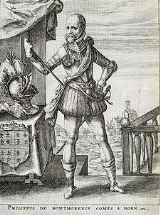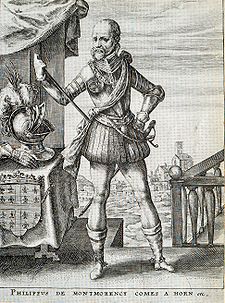
Philip de Montmorency, Count of Hoorn
Encyclopedia

Biography
De Montmorency was born, between 1518 and 1526, possibly at the Ooidonk CastleOoidonk Castle
Ooidonk Castle is a castle in the city of Deinze, East Flanders, Belgium.- History :A fortress was first built on the site of the present castle in 1230, intended to defend the city of Ghent and to fortify the river Leie...
, as the son of Jozef van Montmorency, Count of Nevele
Nevele
Nevele is a municipality located in the Belgian province of East Flanders. The municipality comprises the towns of Hansbeke, Landegem, Merendree, Nevele proper, Poesele and Vosselare. On January 1, 2006 Nevele had a total population of 11,217...
and Anna van Egmont. His father died in 1530 in Italy, and his mother remarried Johan II, Count of Horn, one of the wealthiest nobles of the Netherlands, who, in 1540, left the County of Horne to his wife's children on condition that they should assume his name.
A page and later chamberlain at the court of Charles V
Charles V, Holy Roman Emperor
Charles V was ruler of the Holy Roman Empire from 1519 and, as Charles I, of the Spanish Empire from 1516 until his voluntary retirement and abdication in favor of his younger brother Ferdinand I and his son Philip II in 1556.As...
, de Montmorency married Walburgis of Neuenahr in 1546. He became stadtholder
Stadtholder
A Stadtholder A Stadtholder A Stadtholder (Dutch: stadhouder [], "steward" or "lieutenant", literally place holder, holding someones place, possibly a calque of German Statthalter, French lieutenant, or Middle Latin locum tenens...
of Guelders
Guelders
Guelders or Gueldres is the name of a historical county, later duchy of the Holy Roman Empire, located in the Low Countries.-Geography:...
(Dutch: Gelderland) in 1555, an Admiral of Flanders
Admiral of Flanders
Admiral of Flanders and Admiral of the Netherlands was a title in the medieval Low Countries for the commander of the war fleet....
(Dutch: Vlaanderen), and a knight of the Golden Fleece
Order of the Golden Fleece
The Order of the Golden Fleece is an order of chivalry founded in Bruges by Philip III, Duke of Burgundy in 1430, to celebrate his marriage to the Portuguese princess Infanta Isabella of Portugal, daughter of King John I of Portugal. It evolved as one of the most prestigious orders in Europe...
(Dutch: Orde van het Gulden Vlies) in 1556.
In 1559 he commanded the stately fleet which conveyed Philip II
Philip II of Spain
Philip II was King of Spain, Portugal, Naples, Sicily, and, while married to Mary I, King of England and Ireland. He was lord of the Seventeen Provinces from 1556 until 1581, holding various titles for the individual territories such as duke or count....
from the Netherlands
Netherlands
The Netherlands is a constituent country of the Kingdom of the Netherlands, located mainly in North-West Europe and with several islands in the Caribbean. Mainland Netherlands borders the North Sea to the north and west, Belgium to the south, and Germany to the east, and shares maritime borders...
to Spain
Spain
Spain , officially the Kingdom of Spain languages]] under the European Charter for Regional or Minority Languages. In each of these, Spain's official name is as follows:;;;;;;), is a country and member state of the European Union located in southwestern Europe on the Iberian Peninsula...
, and he remained at the Spanish court until 1563. On his return he placed himself with the Prince of Orange and Count of Egmont at the head of the party which opposed the policy of Cardinal Granvelle. When Granvelle retired, the three nobles continued to resist the introduction of the Spanish Inquisition
Spanish Inquisition
The Tribunal of the Holy Office of the Inquisition , commonly known as the Spanish Inquisition , was a tribunal established in 1480 by Catholic Monarchs Ferdinand II of Aragon and Isabella I of Castile. It was intended to maintain Catholic orthodoxy in their kingdoms, and to replace the Medieval...
and of Spanish rule in the Netherlands. Though Philip appeared for a time to give way, he had made up his mind to punish the opponents of his policy. The regent, Margaret, duchess of Parma, was replaced by the duke of Alva, who entered the Netherlands at the head of a veteran army. Orange fled from the country, but Egmont and Horn, despite his warning, decided to remain and face the storm. They were both seized, tried and condemned as traitors. Ceaseless but vain efforts were made to obtain a fair trial for Horn, and appeals for clemency on his behalf were made by potentates in all parts of the continent. Egmont and Horn were decapitated on 5 June 1568 in the great square of the Grote Markt
Grand Place
The Grand Place or Grote Markt is the central square of Brussels. It is surrounded by guildhalls, the city's Town Hall, and the Breadhouse . The square is the most important tourist destination and most memorable landmark in Brussels, along with the Atomium and Manneken Pis...
(Market Place) before the town hall
Brussels Town Hall
The Town Hall of the City of Brussels is a Gothic building from the Middle Ages. It is located on the famous Grand Place in Brussels, Belgium....
at Brussels
Brussels
Brussels , officially the Brussels Region or Brussels-Capital Region , is the capital of Belgium and the de facto capital of the European Union...
.
Legacy
Nowadays, a statue erected on the Petit Sablon / Kleine Zavel Square, near the Large Market Square in Brussels commemorates the Counts of Egmont and Hoorne, in historical overview usually mentioned together as "Egmond en Hoorne" and hailed as the first leaders of the Dutch revolt, as the predecessors of William of Orange, who grew to importance and obtained the leadership after their execution, and who was assassinated in 1584 in DelftDelft
Delft is a city and municipality in the province of South Holland , the Netherlands. It is located between Rotterdam and The Hague....
, having succeeded in liberating parts of The Netherlands in the early years of the Eighty Years' War (1568–1648).
Van Egmont("Egmond") and De Montmorency ("Hoorne"), who both remained faithful to Catholicism
Catholicism
Catholicism is a broad term for the body of the Catholic faith, its theologies and doctrines, its liturgical, ethical, spiritual, and behavioral characteristics, as well as a religious people as a whole....
, are mostly celebrated as the symbolic leaders in the national history of Belgium, with its catholic majority. William of Orange, brought up as a Lutheran
Lutheranism
Lutheranism is a major branch of Western Christianity that identifies with the theology of Martin Luther, a German reformer. Luther's efforts to reform the theology and practice of the church launched the Protestant Reformation...
, was a proponent of freedom of religion for all people, and grew to fame as the actual powerful leader in the national history of The Netherlands, where protestantism
Protestantism
Protestantism is one of the three major groupings within Christianity. It is a movement that began in Germany in the early 16th century as a reaction against medieval Roman Catholic doctrines and practices, especially in regards to salvation, justification, and ecclesiology.The doctrines of the...
dominated and for many years even ruled as an official state religion
State religion
A state religion is a religious body or creed officially endorsed by the state...
.
The sentence "Den Coninck van Hispaengien heb ick altijt gheeert" in the 1st stanza of the Dutch national hymn Het Wilhelmus ("To the King of Spain I always paid my respect") refers to the initial loyalty
Loyalty
Loyalty is faithfulness or a devotion to a person, country, group, or cause There are many aspects to...
of these three leading figures of the Dutch Revolt, the Counts of Hoorne and Egmont and the Prince of Orange, to Philip II and their claim that they merely objected against some hardships of the Spanish rule over The Netherlands as executed by Philips' emissaries, especially concerning the taxation and the merciless and cruel religious prosecutions, in the form of hanging and burning of protestants by the Spanish Inquisition, the latter being a human rights
Human rights
Human rights are "commonly understood as inalienable fundamental rights to which a person is inherently entitled simply because she or he is a human being." Human rights are thus conceived as universal and egalitarian . These rights may exist as natural rights or as legal rights, in both national...
issue before this term was coined in the 18th Century.

